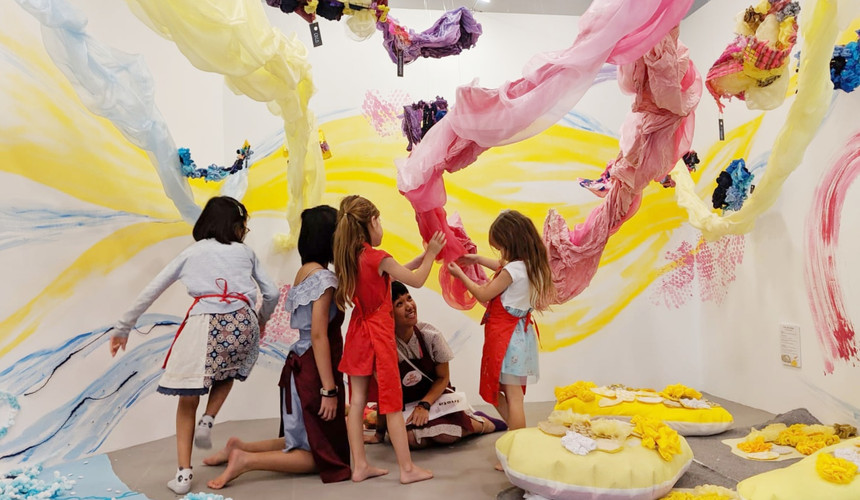Welcome to our first blog post of Art Wonderland, mummies, daddies and educators! Here we aim to share only all the good things! Think art tips for your little artist, insider discounts to our art programmes and events, free printables, art activities that you can do at home, and understanding art education at its core. Here at Art Wonderland, our teachers wear many hats. As practising artists as well, we call ourselves, Artist Educators!
We've been wanting to share more about our art processes here in our studio art classes, who our amazing and dedicated artist educators are, and the important teaching values we strongly believe in!
We believe that art education is an essential development that not only nurtures your child's inner artist, but also builds character and confidence! Here's why we strive to incorporate these important art education values during our lessons that also extend to our conceptualisation process when creating children-friendly art installations here at Art Wonderland.
1. Encouraging children's curious and inquisitive nature!
In our lessons, we ask about 101 questions! As you may have heard, there are no right or wrong answers in art, that's why we keep our questions open-ended to stimulate the child's critical and creative thought processes that lead them to tackle a challenging concept. Allowing them to understand the subject at their own pace encourages them to tackle even tougher concepts in the future!
Parent pro tip: Keep asking 'why'! Asking your child 'why' will encourage them to think deeper and more consciously. It will help in articulating their thoughts to you, at the same time practice verbal communication!
2. Sharpen observation skills through inquiry-based questions!
This enhances visual literacy, the ability to 'read' a picture, process this new information and articulate it into words! This helps children to develop their cognitive skills and provide them with the tools they need to make sense of the world around them.
Our curriculum is based on Howard Gardner's Multiple Intelligences and promotes integrated learning of concepts such as numeracy, literacy and discovery of the world through the Arts. Art Wonderland also conceptualises art installations for children to explore and be immersed in an interactive art space. This takes learning out of the classroom and opens their view of art to a much bigger scale!
If Lines Could Dance...
2019
Children's Interactive Art Installation by Lead Artist Stacy Huang, Artist Educator from Art Wonderland.
Art Wonderland has been the official Children's Art Studio partner for Affordable Art Fair since 2017.
Parent pro tip: Ask questions when you're out and about with your kids ! There are learning moments everywhere you go.
3. Lots of experimenting and problem solving!
This is our favourite part of teaching and learning - when we see our kids light up from solving their own problems! Lots of troubleshooting is needed during art, and needless to say, lots and lots of experimenting. This is why we provide a sketchbook for each child to explore with the medium or technique, and to document their learning processes.
Incorporating science into our art lessons. We are building a drawing machines that involved lots of problem solving to ensure the gears and arms move in synchronisation. Happy with her results at the end!
Parent pro tip: Give your child lots of opportunities to explore with their art, the process is all about experimenting and making mistakes along the way!
4. To express themselves and be creative!
Just be creative! Make a mess! Understand that art does not confine you to a single medium - art is much more than a drawing!
Parent pro tip: With exploration sessions like this, just provide one medium and encourage many different ways of using this medium. You could start with watercolour paint, experimenting with techniques like wet-on-wet, wet-on-dry, colour mixing , using other materials to paint and more! Put down a plastic sheet or table cloth, with a rag nearby for easy clean up!
5. Engage in practising fine motor skills!
Exploring various art techniques such as painting, drawing, 3D materials such as clay to engage and develop fine motor skills which are important for your child to complete everyday tasks. Our curriculum allows for the use of traditional as well as non-traditional mediums to introduce children to various forms of art.
Parent pro tip: Don't be afraid to use scissors at home! Teach your little ones how to use the scissors responsibly, directing them their hands to go in a 'open' and 'close' motion. You can also guide your child's fingers by putting your hand beside theirs.
6. Learning through artful play!
Last but definitely not least, we incorporate other subjects into our lessons. Art is the perfect medium to share more about the world, learning about biodiversity, our human body, and so more. There's just so much to learn and share about!
While our teachers work on our art curriculum to provide a holistic lesson for our kids, we keep these values in high regard to engage and inspire your child within 1.5hours - and come out as stronger thinkers and of course, feeling free to express and create - and also be happy little artists!
Catch us weekly to get insider news and keep current with Art Wonderland's programmes and ongoings! We'll keep this space updated about our new finds in art education for you and your child too!

About Jesse
During my college days in LASALLE, I taught my first children art class in 2012, and been exploring the art education field ever since! I strongly believe that art is a powerful and essential tool in a child’s development to understand the world around him and to build confidence with everyday tasks. With this, I hope to spread the importance of incorporating art into the lives of children, one day at a time!






















































Comments